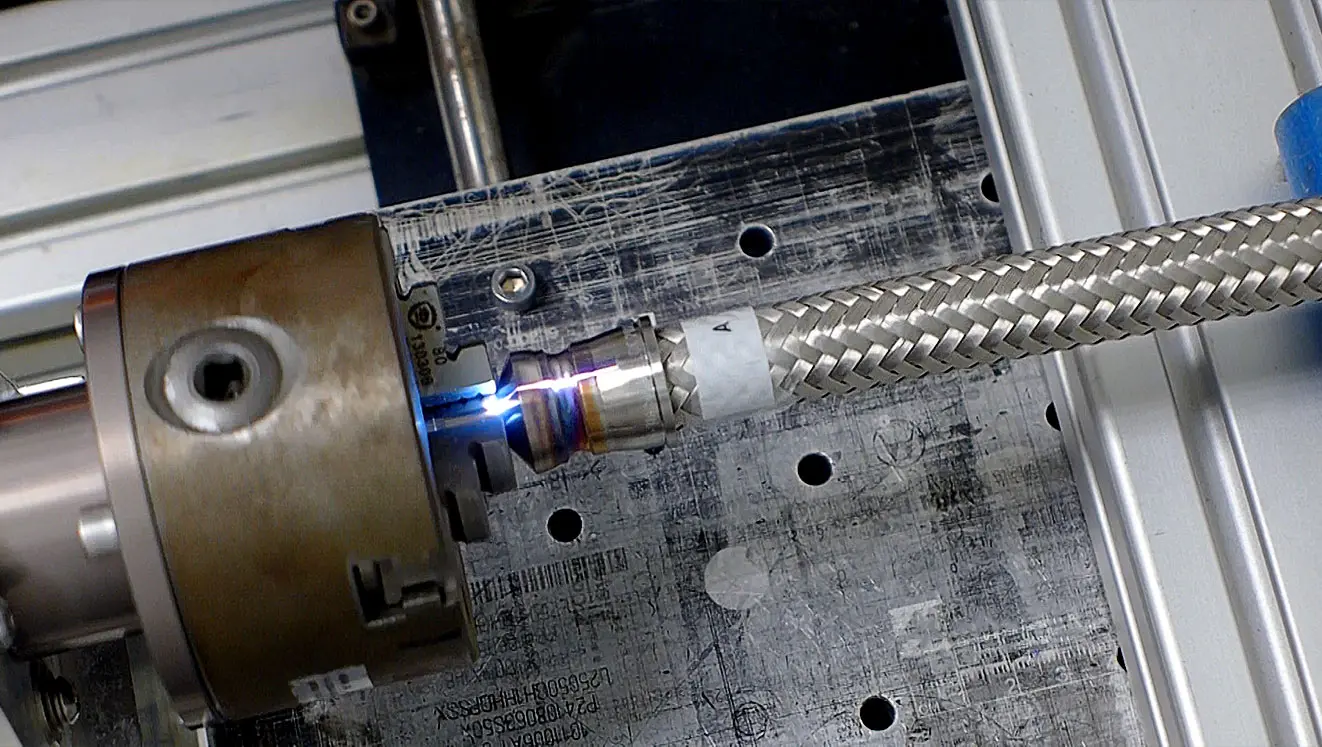Laser welding is favored by manufacturers of complex and delicate components due to its exceptional precision and control. A focused laser beam with the right parameters can produce seams of micron-level tolerance – which is difficult to achieve with conventional welding techniques. Today, sophisticated laser technology is integrated into automated processes in such challenging areas as: micro-welding of conductive materials; electronics and battery manufacturing; hermetic sealing of medical devices; clear-on-clear welding of transparent plastics; and joining of dissimilar materials, to name a few.
Exceptional Precision, Control & Versatility
When joining tiny components or intricate assemblies, precise heat control is critical to avoid melting or deformation. Laser welding is a non-contact process that directs a focused, oscillating laser beam to the exact required locations, allowing fabricators to contain the heat-affected zone (HAZ) and reduce material fatigue while achieving strong welds.
Furthermore, laser parameters like spot size, focus depth, power, and pulse duration can be finely tuned and optimized to match specific welding applications, ensuring stable welds with minimal spatter and repeatable, high-quality finishes. This precise energy input also contributes to maintaining the material’s integrity and aesthetic appeal, often without the need for post-processing.
Used across many industries and manufacturing processes, laser welding is highly versatile. From joining plastic-to-plastic (even clear-on-clear plastics), plastic-to-metal, and various metal-to-metal combinations like stainless steel, copper, gold, aluminum, and titanium, even dissimilar ones, laser welding produces high-quality seams. It excels in handling complicated shapes and sizes, from intricate designs and difficult-to-reach areas to extremely small joint areas required for miniature components.
This technology allows for flexible weld patterns, 2D and 3D weld paths, and various techniques including conduction, keyhole, spot, and seam welding. This adaptability makes it suitable for both high-volume production and complex research and development applications.

CMS Laser: Automated Solutions for Challenging Tasks
CMS Laser, a Laser Photonics subsidiary, offers a comprehensive range of laser welding solutions, distinguished by their precision, versatility, and advanced technological integrations, catering to numerous industries, complex applications, and high-volume production environments.
- Custom-Engineered Solutions
CMS Laser acts as an engineering partner, developing comprehensive, start-to-finish systems for customers’ specific needs;
- All-Encompassing Laser Capabilities
Integration of any type of laser available on the market, catering to applications including high-precision welding of metals, plastics, clear plastics, and more;
Automated operation and complete parts handling, in-house developed computer control, camera vision for real-time weld path tracking, AI for defect detection, rotary unit with tilt capability, gas assist for stable welding environment, and more;
- Complex Challenges Resolved
Unique solutions for welding miniature components, airtight seals, dissimilar materials, complicated shapes and sizes, intricate designs, and difficult-to-reach areas.
CMS Laser’s solutions are utilized across diverse industries including automotive (fuel pumps, transmission pans, airbag chute channels), aerospace (stainless steel components), medical device manufacturing (implants, hermetically sealed containers, surgical instruments, micro fluidic components, bio scrub brushes), electronics, and more.
Laser Photonics’ WeldTech: Handheld Welding Systems
Laser Photonics’ WeldTech is designed to meet the growing demand for metal welding applications that require handheld control. Designed for manufacturing and maintenance scenarios that demand portability, maneuverability, and human involvement. Utilized across auto repair shops, mold and die repair, thin metal welding, and metal workshops.
WeldTech systems integrate a continuous wave fiber laser source that provides high beam quality and brightness. Its shorter wavelengths result in less issue with welding plumes compared to CO2 lasers, which can improve stability. The beam is delivered from the mobile system to the handheld blaster via a flexible fiber optic cable, offering “plug and play” usability. This leads to reduced cycle times in production, for example, significantly cutting welding time in automotive applications, and generally results in a lower price per weld compared to CO2 lasers, making it a highly cost-effective and versatile solution.
From ultra-thin foils to high-strength alloys, WeldTech ensures repeatable results in environments where consistency is critical. Its ability to integrate into production lines allows manufacturers to embrace automated laser welding without sacrificing quality. With a thin beam and tightly controlled energy delivery, WeldTech minimizes heat-affected zones while maximizing bond strength. The result? Stronger welds, reduced material fatigue, and precise results.
Precision at Every Scale
As manufacturing moves toward smaller components and more detailed assemblies, laser welding plays a critical role in meeting exacting technical requirements. From microelectronics to medical devices and aerospace parts, the ability to produce clean, repeatable welds with minimal heat input is essential.
Laser Photonics and its subsidiary CMS Laser support this need. Whether it’s advanced automated systems for complex production tasks or handheld tools for flexible on-site work, our equipment is designed to deliver consistent results across a wide range of materials and applications.
With finely controlled energy delivery, minimal material distortion, and broad material compatibility, laser welding continues to meet the challenges of modern manufacturing at both small and large scales.
Learn more about our laser welding systems and how they support precise, consistent production.
Speak to a Laser Specialist